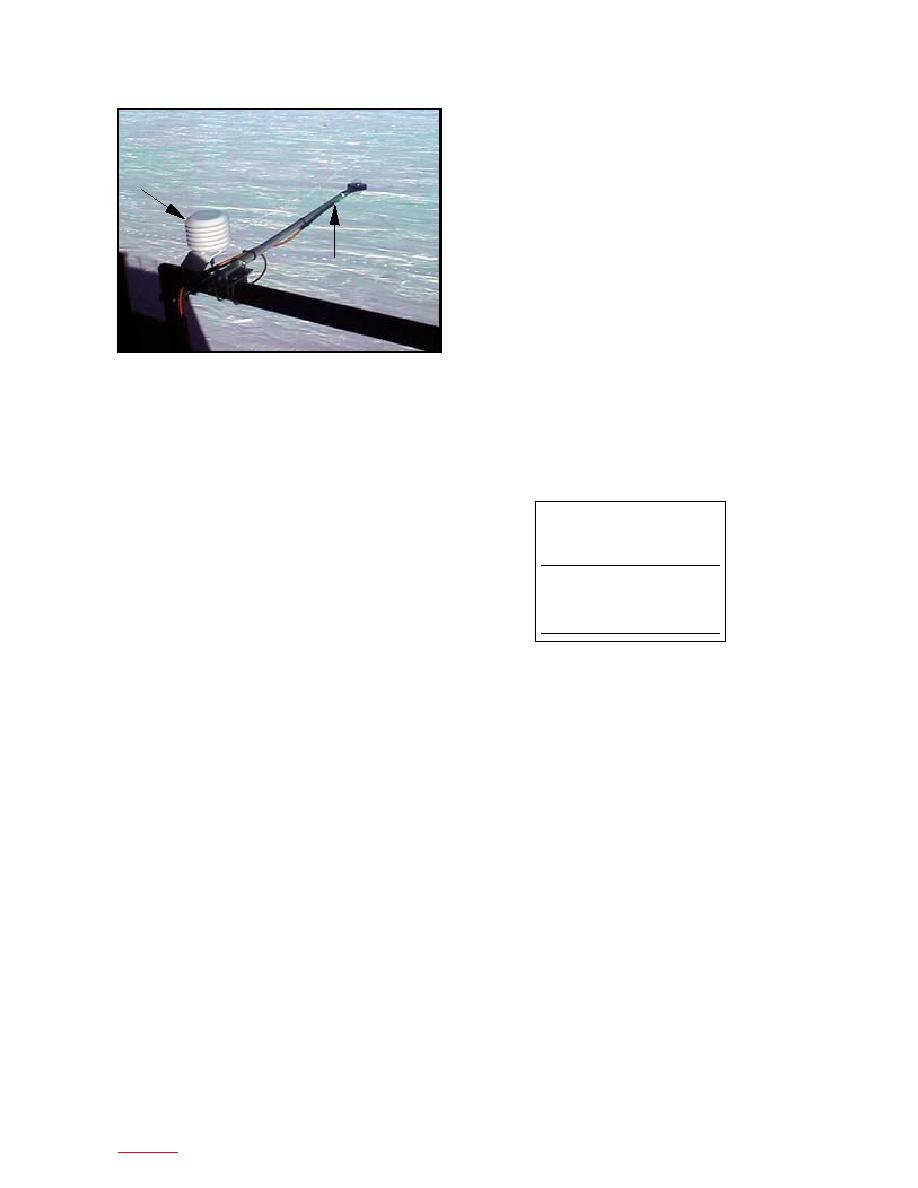
frame surrounding the PV module and glazing was very
tight and had only slight movement when a twisting
motion was applied. The glazing, panel back, and junc-
tion box were all free of defects.
Solarex, MSX-50
The Solarex panels also showed no signs of any
structural defects. The aluminum frame experienced
very little flex when a twisting motion was applied. The
aluminum frame was tight to the PV module and glaz-
ing surface. The glazing, panel back, and junction box
were all free of defects.
Measure of PV panel flex
To determine the flex (rigidness) of a PV panel, a
simple fixture was constructed. It held three corners of
Figure 10. Temperature sensor with radiation shield (left
arrow) and Q-7 net radiometer in horizontal position (right
the PV panel in a fixed position, while the fourth cor-
arrow).
ner was left free to allow the PV panel to be pulled to
simulate a twisting motion. Each PV Panel that was
Ambient air temperature
tested had approximately 8 lb (35.6 N) of tension
The ambient air temperature sensor (Fig. 10) uses
applied to the free corner. The deflection attributable
the same thermistor (107B temperature probe) as does
to the twisting motion was then recorded (Table 3).
the PV panel temperature sensor. Like the PV panel heat-
ing sensor, the ambient air temperature sensor was
polled by the CR10X's P4 instruction. Unlike the PV
Table 3. PV panel flex.
panel temperature sensor, a solar radiation shield has
PV
Deflection
been added to ensure that the true ambient temperature
panel
(in.)
(cm)
was measured.
KYOCERA
0.375
0.9525
ASE Americas
0.500
1.27
RESULTS
Solarex
0.750
1.905
PhotoComm
1.125
2.858
PV panel inspection prior to installation
KYOCERA, LA-51
Processed data
No obvious defects were found in the KYOCERA
All data sent from the South Pole from 25 November
PV panel. The aluminum frame surrounding the PV
1997 to 2 December 1998 have been processed into
module and glazing exhibited great strength. When a
one data file. That data file has been analyzed to pro-
twisting motion was applied to this PV panel, the alu-
vide following.
minum frame barely flexed. The glazing, panel back,
Performance of all PV panels from 25 November
and junction box were all free of defects.
1997 through 2 December 1998.
Performance of all PV panels over 24 hours on a
PhotoComm, Inc., DV-50-AL
high-visibility day.
On all four of the PhotoComm, Inc., panels that we
Performance of all PV panels over 24 hours on a
inspected, the gasketed seal between the glazing and
low-visibility day.
aluminum frame showed signs of failure. The gasketed
Net radiometer readings from 25 November 1997
seal was pulling out of the corners between the glazing
to 2 December 1998.
surface and aluminum frame. Each panel showed some
Situation report (SITREP) data, 19971998.
signs of aluminum frame weakness. The corner connec-
tions of the frame were loose and allowed considerable
Overall PV panel performance
movement when a twisting motion was applied. Three
Figures A1A16 were created to show the perfor-
of the frames showed signs of abuse; they had dents
mance of each PV panel. PV power output and PV panel
and or were bent. The glazing, panel back, and junc-
temperature are parameters of interest. The readily avail-
tion box were all free of defects.
able PV power coincided with the sun declination an-
gle. At the highest sun declination angle (23.5), the
ASE Americas, ASE-50-AL
PV panels exceeded or approached their rated PV power
The ASE Americas' panels are well built. No defects
output. As available PV power increased, PV panel heat-
were detected from a visual inspection. The aluminum
7
to contents



 Previous Page
Previous Page
